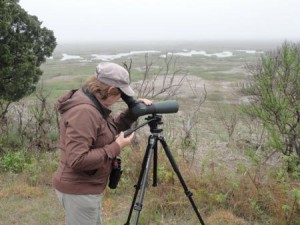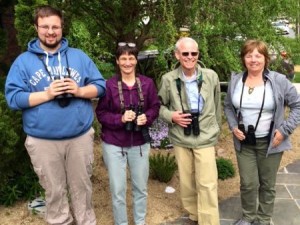A team of four birders found 76 different species of birds in Ocean City between dawn and dusk on Saturday.

The team — dubbed “One Good Tern” to highlight Ocean City’s beach environment — competed in the World Series of Birding on May 9.
The statewide event sends teams fanning out across New Jersey in a race to count as many bird species as they can identify by sight or sound within 24 hours. New Jersey Audubon started the World Series in 1984 to raise money for environmental causes and to focus attention upon the habitat needs of migrating birds.
The local team is comprised of: Nancy Larrabee, who was part of the inaugural Ocean City team formed eight years ago and who has acted as team captain every year since; Mike Johnson, an Ocean City resident who is on the team for his third year; and Jeffrey and Lynn Faust of Philadelphia, who are huge fans of Ocean City’s natural areas for birding.

Unlike other teams traveling across the entire state during the World Series, “One Good Tern” limits its search to only Ocean City.
‘Besides the sheer enjoyment of birding and the fun of competition, the team participates each year in order to highlight the importance of the remaining natural areas in Ocean City,” Larrabee said. “Though few in number and size, those natural areas are critical to sustaining migrating birds such as warblers flying to the north each spring. Of particular importance is the Corson’s Inlet State Park, located on the south end of the island.”
_________
She said Ocean City is lucky to have plenty of pristine habitat for resident and migrating coastal birds on its beaches, meadows and bays, and the team regularly gets top points in its shorebird counts. The team also has found that neighborhood yards and gardens that have been planted with native plants are attractive to migrating and resident birds.
The team actually was “slightly disappointed” in its count of 76 species this year, having identified 109 last year in Ocean City alone. The winning team this year counted 208 species statewide.
The foursome met at dawn and first traveled the rail trail at Corson’s Inlet State Park, then followed a sand path through the low scrub to the beach. But a thick fog made identification of sea birds nearly impossible.
The fog and a steady sea breeze made conditions far less than ideal as the east winds pushed birds toward the mainland.
The rules of the game require all four members to hear or see almost all species (an exception allows only two members to identify five percent of the species counted), and team members rely on mnemonic devices (“sweet sweet sweet I’m so sweet,” for instance) to pick out songbirds like the yellow warbler from among the fog and underbrush.
The team would move on to the causeway between Ocean City and Strathmere, the Howard S. Stainton Wildlife Refuge off Bay Avenue near the Ocean City Municipal Airport, the Ocean City Municipal Golf Course, the Ocean Reef Club Condominiums off Tennessee Avenue, a handful of identified private yards with native plants, and north end beach jetties, among other spots.
By 8 a.m., the team had identified about 25 species, and by noon 64.
The team found almost no migratory species due to the unfavorable winds. A favorite sighting was a flock of 24 whimbrels, wading shorebirds with long curved bills.
“Conditions were pretty tough, but we still had a great day birding,” Larrabee said.
The last sighting of the day was a bald eagle appearing out of the fog.
“It makes you appreciate where you live,” Larrabee said.





